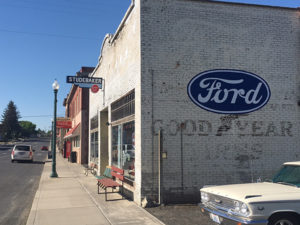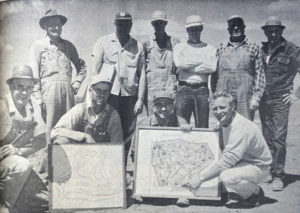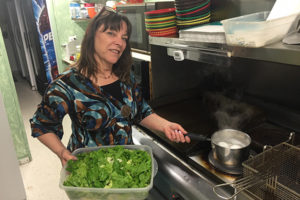by Bob Bostwick
Driving 13 miles south of Davenport in Lincoln County outside of Spokane, on State Highway 28, a slight left turn puts you onto 3rd Street in Harrington, Wash. It’s the main drag.
As you enter, you’ll see no “Welcome to Harrington” sign, but on this bright and sunny morning in late spring, there’s no need for one.
You’re greeted by tidy lawns and the smell of fresh cut grass, orange and yellow tulips waving at you from small gardens in front of small houses. The welcome here is plenty clear, and plenty warm.
Harrington is a throwback town, its 401 residents attached directly or indirectly to the agricultural bounty surrounding it – about 90 percent wheat. Furrows of barley here and there and some good ground for cattle and tall grass complete the landscape.

Almost treeless, it’s too far north to be in the Palouse, too far east to be in the Columbia Basin.
The place has charm, its century-old buildings standing as reminders of a town bigger than this. Life seems good, certainly quiet, and the locals seem determined to thrive in all that.
Lincoln County barely reaches 10,000 population. There are eight incorporated towns, a slew of rural communities, and not one traffic light among them.
On 3rd Street, merging with the Harrington-Tokio Road to Ritzville, the town continues for about a mile. At its midsection, you could cross it with a driver and a five iron. On the south end of town, the story of Harrington is impressive enough with what is arguably the finest nine-hole golf course in Washington, maybe the entire Pacific Northwest.
But the story, as it relates to golf, goes far deeper, and far more personal regarding those living here in 1962, and those living here now.
The Harrington Golf and Country Club was built by these folks, their hearts and minds every bit as fertile as the 70 acres of Jack Boyer’s wheat field they converted, a project that began with a $45,000 loan from the U.S. Department of Agriculture’s Farmers Home Administration. The Kennedy Administration made such funds available for converting farmland into recreational use, among other community improvements.
“This could very well be the greatest single achievement for Harrington, and all of Lincoln County,” predicted then-Mayor Erv Ostereich in 1962. “The golf course will provide recreation and beauty for all to enjoy.”
Neither the federal money nor the donations from the local Lions Club ($2,380), the Old National Bank ($250) or local fertilizer companies ($250) would ever cover more than a fraction of the costs for plans that included general beautification, improvements at the town park and the new golf course. People had to show up and volunteer – and they proceeded to answer that call in epic proportions.
They drilled a well, producing as much as 1,000 gallons per minute, 250 more than they needed. They dug irrigation ditches, laying 16 miles of piping and tubing for 273 sprinkler heads, all to run automatically.
From these flowing fields of spring and winter wheat came farmers with bulldozers, trucks, backhoes, spreaders, seeders, and all the hands necessary to operate each one.

Throughout 1963, ‘dozers moved uncounted tons of dirt, shaping the Robert Putman design. With the growing season underway and harvest coming by late July, everything was done in haste. Dozens of townspeople, including their children, combed the site, removing rocks and other debris.
Putman, coming to inspect, and expecting flaws at every turn, found none. Absolutely none.
The intent was to build a nine-hole course unlike any, anywhere. Putman’s design features fairways lined on either side with a variety of deciduous trees and conifers. Fairway bunkers guard doglegs and every green features gaping traps, daring you to go for a pin.
In 1964, spring planting in this part of Lincoln County saw a slight change. It included bluegrass and rye for fairways, bentgrass for greens. By growing season, one element – sand, lots of sand – was still missing.
Farmers brought trucks, hauling 1,097 loads of sand on an 18-mile round trip, and doing so in 44 hours. Tree seedlings planted, the Harrington Golf and Country Club was ready for play in September 1964.
And that, folks, is how you build a golf course for yourself and your neighbors.
As is the case here, it took a village to raise a golf course. And it takes a village to keep it going these 54 years.
In fact, it takes over 1,500 volunteer hours, including Randy Behrens, the retired Superintendent of Schools, in charge of a persnickety irrigation system.
Scott Hutsell, a Lincoln County Commissioner and Les Schwab store owner in Davenport, takes on all chemical applications.
From the high school, the local chapter of Future Farmers of America shows up every fall and spring, raking leaves and cleaning up. They get a hamburger.
The course rises from north to southeast, the highest point at the tee box on No. 7, a 156-yard par-3 that drops about 80 feet, guarded in front by one of seven water hazards and Putman’s signature bunkers on either side.

But it’s No. 6 that is most troublesome. “The Beast” is the general reference to this 549-yard par-5, mostly uphill, from east to west and into the prevailing wind, deep rough available to the right and an out-of-bounds wheat field on the left.
The membership, about 60 men and women, includes players from Davenport, Creston, Reardon, Edwall and Sprague. The ladies own Thursdays, the men have their regular games on Wednesdays and Saturdays. Bring money. Not much, but some.
The biggest event here is the work of local legend Linda Knapp. She played in the U.S. Women’s Amateur Public Links Championship four times, no longer plays to a two handicap, but her standup comedy is still the talk of the town.
Dressed in a nun’s habit, she’s the main event at her annual Women’s 2-in-1 tournament, August 24-26, now in its 40th year.
At 74, she loves a good joke. She loves golf a bit more. And she fell in love with this golf course when she came to these parts over 50 years ago, her degree from Whitworth College in hand and jobs teaching music for the area public schools in her path.
“It’s meant the world to me,” she said. “We have great friendships, and the tournament has brought the best golfers from five states. They come here because they love to play this course. It gives you the opportunity for every shot in your bag.”
Life in Harrington, typical of a small town, remains slow. And that’s a big draw for some, including former Seattleites Justin and Heather Slack, who moved here with their two young children almost four years ago. He continues in the banking industry, including frequent flights from Spokane. She operates the Post & Office, a coffee house and small menu eatery in the heart of town.
Their establishment offers locals a place to gather, as is done in small towns, where local, national and world affairs can be discussed and resolved. Excepting the golf course café, it’s the only spot in town to do so. Not only have they established roots, Justin got himself elected to the city council.
“It’s the best thing we ever did,” said Heather. “We found a wonderful small community with good schools. Our children can have the run of town, and we don’t have to keep an eye on them when they go outside.”

At the golf club, Melissa Gilmore manages a small staff. She cooks, serves and runs play from the downstairs café of a 4,000 square-foot clubhouse, the upstairs available for awards ceremonies and meetings. The food is excellent, the cost low. A beer sells for $2.75, and she makes her own ice cream and cookie sandwiches.
Harrington could be the centerpiece of an Eastern Washington nine-hole golf trail. The story here is similar to development of nine-hole courses in Wilbur, Odessa, Ritzville, St. John and Colfax, and they’re all worthy of praise.
Knapp speaks from the heart to her returning tournament players, telling them, “It has been a great joy in my life for 40 years to see you walk through the clubhouse door.”
That’s why this town needs no welcome sign. Knapp seems to speak for what you find on Harrington’s 3rd Street and beyond, for the folks playing nine holes on this memorable course, and to all who might ever “walk through the clubhouse door.”
Bob Bostwick is a former sportswriter and member of the Golf Writers Association of America, a television news anchor, political reporter and editor, and a publicist. He has won numerous local, regional and national awards as a journalist and filmmaker.

